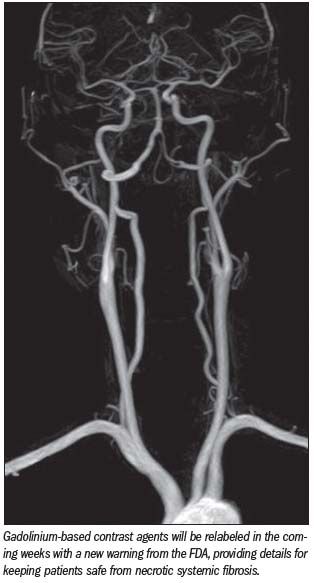New warning on MR contrast labels adds safety details
Current labeling already warns about the risks of gadolinium for patients with impaired kidney function.
Current labeling already warns about the risks of gadolinium for patients with impaired kidney function. The changes in medical practice since this warning appeared in 2007 and the general awareness of the risks before and since then have caused the incidence of necrotic systemic fibrosis to plummet.
The director of the FDA's division of medical imaging products, Dr. Dwaine Rieves, wants to keep it that way with new labeling that will help minimize the risk of NSF on a long-term basis.
As a result of the FDA’s new initiative, three of the most popular MR contrast agents-Magnevist by Bayer Healthcare, Omniscan by GE Healthcare, and Optimark by Covidien-will carry labels warning that their use is “inappropriate” for patients with acute kidney injury or chronic severe kidney disease.
These three were found by FDA reviewers to be associated with a greater risk than other such agents for NSF in certain patients with kidney disease. But, because NSF may follow the use of any gadolinium-based agent, all such contrast agents will carry new warnings emphasizing the need to screen patients for kidney dysfunction that puts them at risk for this rare but potentially fatal condition.
The new labels will better characterize one of the high-risk groups, those with acute kidney injury, while emphasizing the importance of screening patients. The new text will also emphasize the need to record the specific contrast agent administered and the dose.
“One of the particular concerns from postmarketing reports was lack of information regarding which of the GBCAs (gadolinium-based contrast agents) was actually administered to a patient, as well as the dose,” Rieves said.

From a clinical standpoint, however, the problem has already been solved. Dr. Richard H. Cohan, a professor of radiology at the University of Michigan Health System and chair of the American College of Radiology’s committee on drugs and contrast media, says increased awareness of NSF and the factors associated with it have already changed practices.
“Thank goodness this issue has already been successfully combated by the overwhelming majority of practices,” Cohan said. “People are very aware of this issue-partly due to the modern age of the Internet, where information can be disseminated very quickly.”
Radiologists now try to avoid the use of MR contrast for patients with severely impaired kidney function, Cohan said. In cases when this is not possible, they try to give the minimal effective dose using agents other than the three most often associated with NSF.
MINIMUM EXPECTATIONS
New labeling requirements from the FDA will formalize the core safety issues in text that Rieves describes as containing a “minimum expectation” for the labeling. Manufacturers began reviewing this text in early September.
They were allowed to enhance it or make alternative proposals, Rieves said, subject to FDA approval. He expected the labeling process to be complete by the beginning of November.
The FDA based its text on findings coming out of a December 2009 FDA advisory committee. In its review of postmarketing reports, new animal and in vitro reports, and published reports, the committee determined that labeling changes were needed to enhance the safe use of gadolinium agents. Magnevist, Omniscan, and Optimark were singled out because of the FDA’s determination that these three agents are associated with a greater risk for NSF than others.
Lantheus Medical Imaging, whose blood pool contrast agent Ablavar is one of four other agents subject to the new warning, describes the revised language as providing clearer guidance to healthcare professionals about the risk of gadolinium-based agents.
EXTRA MEASURES
In addition to the warnings being written into the labels, the FDA recommends that staff perform laboratory tests on patients at risk for chronically reduced kidney function to estimate kidney function, avoid the use of gadolinium-based contrast agents in patients suspected or known to have impaired drug elimination processes unless the imaging is essential and not available without contrast, monitor for signs and symptoms of NSF if a gadolinium agent is administered to a patient with acute kidney injury or chronic, severe kidney disease, and administer a gadolinium agent only once during an imaging session.
MRI Study at ARRS Raises Questions About Disparities in Detection of MASLD
May 3rd 2025New research revealed that Hispanic Americans with evidence of hepatic steatosis on MRI but no formal diagnosis of MASLD had over a fourfold higher risk of developing hepatocellular carcinoma in comparison to those who had a formal diagnosis of MASLD.